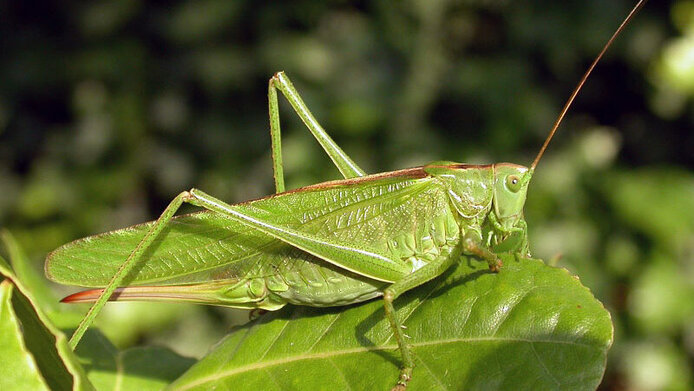Strategies of locusts being used for new active substances

Although not exactly the classic model animals in neurobiology, locusts turned out to be exactly the right choice for Christian Gruber's research at the Medical University of Vienna, because new insights into the biology of these insects may have a major impact. After all, with about 11,000 species, they form one of the largest animal groups on our planet. The swarming behaviour of the family of migratory locusts in particular has led to its colonising almost all continents. The largest known swarm of locusts comprised several billion animals, which corresponds to a total weight of about 27 million metric tons. Since these insects consume approximately their own body weight in plant material every day, they wreak considerable agricultural damage in many places. That negative aspect aside, however, locusts are highly relevant in terms of biomedical perspectives.
Molecular lifestyle components
Gruber discovered interesting aspects in his FWF-funded project “Function of oxytocin neuropeptides in locusts”, which he conducted in collaboration with the biologist Jozef Vanden Broeck from the Department of Animal Physiology and Neurobiology at the University of Leuven in Belgium. He sums it up thus: “Certain signalling substances of the nervous system, so-called neuropeptides, play an important physiological role in the behaviour and water balance of locusts. In earlier studies, the biochemist was already able to show that these neuropeptides also regulate aspects of foraging, locomotor activity, and metabolism in ants. The hormone system of both insect species is genetically based on the neuropeptides oxytocin and vasopressin, which corresponds to the human hormone system.
Docking site for medical agents
Oxytocin is widely known as the cuddle hormone. In conjunction with the hormone vasopressin, it influences labour activity during the birth process and stimulates the flow of mother's milk, to mention but two effects. While it plays a particularly important role in regulating the water balance in the kidneys, vasopressin also influences the blood flow in the uterus. “Oxytocin-vasopressin receptors, which belong to the large family of G protein-coupled receptors, are the best known target group for medical drugs. 30 per cent of all available drugs are based on these receptors, for example against hypertension or certain heart conditions,” explains Gruber. Put in simple terms, these receptors help to transport information into the interior of our cells. At the same time, they activate various molecular signalling pathways in the cells, which can lead to both desirable and undesirable effects.
Science needs creativity
Christian Gruber has dedicated his research to finding targeted therapeutic applications based on plant and animal mechanisms. “I sometimes see myself as being not unlike a creative artist: you acquire a knowledge base, but then you can really propose any question and work on it. Always provided you get appropriate funding, of course. And you have to learn to live with the fact that you don't always get answers,” notes the multi-award-winning Gruber, who has already done research on various continents and in the rainforest. This is the question he is currently exploring: “How can we use insect hormones and receptors, which are related to ours, for therapeutic applications in humans?”
Using nature's blueprints
The details are hugely complex. Using state-of-the-art biological and pharmacological methods, Gruber and his team are now taking a closer look at oxytocin-like neuropeptides in locusts. “We examined how, in locusts, the hormone oxytocin selectively binds to the receptor. By better understanding this selective signal transduction in cells in animal models, we can also use it for humans to distinguish and selectively address receptors in tissue.” The novel concept can be pictured roughly as follows: after studying the structure of an insect neuropeptide, the researchers recreate it with minor chemical changes to gain a better understanding of signal transduction. In the future, this could help to generate optimised active substances for use in humans.
Synthetically optimised peptide hormones could eliminate undesirable side effects, but this still requires further research. Gruber puts it like this: “What we learn about selectivity in neuropeptides can also be applied to many other human signalling systems.” Last but not least, the biomedical findings also benefit agriculture, since they offer new possibilities for targeted pest control and can thus improve agricultural production and quality of life in the regions concerned.
Personal details
Christian Gruber studied biochemistry at the University of Tübingen and molecular biotechnology at the Queensland University of Technology in Australia. In his student days he was already focusing on cyclical plant peptides. A Lise-Meitner project of the Austrian Science Fund FWF led Gruber to Austria and the Medical University of Vienna, where he currently works at the Centre for Physiology and Pharmacology. His innovative research has already been honoured by several awards. The FWF funded his project “Function of oxytocin neuropeptides in locusts” (2017–2021) with EUR 172,000.
Publications
Dekan Z., Kremsmayr T., Keov P., Godin M., et al.: Nature-inspired dimerization as a strategy to modulate neuropeptide pharmacology exemplified with vasopressin and oxytocin, in: Chemical Science, Vol. 11, 2021
Muratspahić E., Monjon E., Duerrauer L., Rogers SM: Oxytocin/vasopressin-like neuropeptide signaling in insects, in: Vitamins and Hormones, Vol. 260, 2020
Muratspahić E., Freissmuth M., Gruber CW: Nature-Derived Peptides: A Growing Niche for GPCR Ligand Discovery, in: Trends in Pharmacological Sciences 2019





